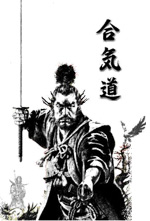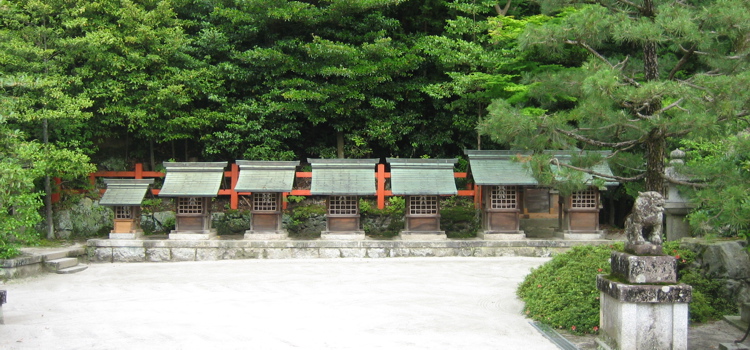
Miyamoto Musashi ( 1584–June 13 (Japanese calendar: May 19), 1645 ) was a famous Japanese samurai, and is considered by many to have been one of the most skilled swordsmen in history. Musashi, as he is often simply known, became legendary through his outstanding swordsmanship in numerous duels, even from a very young age. He is the founder of the Niten Ichi-ry or Niten-ry style of swordsmanship and the author of The Book of Five Rings ( Go Rin No Sho ), a book on strategy, tactics, and philosophy that is still studied today.
For an historic person who is revered in Japan, there is a lot that is not known about his life, especially the early part.
What is well known, however, is that between the age of 13 and 30 Musashi is said to have fought over 60 duels and was never defeated, although this is a conservative estimate, most likely not accounting deaths by his hand in major battles, often using only a bokken (wooden sword).
To just survive this number of duels let alone never being defeated was unheard of. What is more surprising is that he was largely self-taught and often, as a young man, matched himself against swordsman with superior technical skills.
In the Book of Five Rings Musashi states that he taught himself the sword by practicing and studying diligently. A clue as to how he did this can be found by studying his paintings and carvings. These clearly demonstrate that he was a man of keen observational abilities. It can be imagined that as he wandered (technically Musashi was a ronin, or master-less samurai, throughout his life) perfecting his art, offering and accepting challenges, he would have visited dojos and talked with other wandering samurai also following the sword path. By carefully watching and listening he could take away skills and techniques that he would then incorporate into his own fighting style.
Musashi created and perfected a two-sword kenjutsu technique called niten'ichi ( "two heavens as one") or ichi (, "two swords as one") or "Ni-Ten Ichi Ryu" (A Kongen Buddhist Sutra refers to the two heavens as the two guardians of Buddha). In this technique, the swordsman uses both a large sword, and a "companion sword" at the same time, such as a katana and wakizashi.
It is said the two-handed movements of temple drummers inspired him, although it seems more likely that the technique was forged by a means of natural selection through Musashi's combat experience, or from jitte techniques which were taught to him by his father- the jitte was often used in battle paired with a sword; the jitte would parry and neutralize the weapon of the enemy whilst the sword struck or the practitioner grappled with the enemy. In his time a long sword in the left hand was referred to as gyaku nito. Today Musashi's style of swordsmanship is known as Niten Ichi-ry.
Musashi's most famous duel occurred On April 14th 1612 when he was 28 or 29 against superior fencer Sasaki Ganryu Kojiro who had developed a strong fencing technique known as Tsubame-gaeshi, or "swallow counter", inspired by the motion of a swallow's tail in flight. Apparently Sasaki would stand in a field with swallows flying around him and when one would fly close enough he would draw his sword and cut it down on the wing. Sasaki was an exceptional swordsman trained in the venerable Chujo-ryu sword school. He was cultured, refined and had affiliations to the powerful Hosokawa clan. Kojiro was retained by the lord of the province, Hosokawa Tadaoki. Musashi applied to Tadaoki for permission to fight Kojiro through the offices of one of the Hosokawa retainers who had been a pupil of Musashi's father, one Nagaoka Sato Okinaga. Permission was granted for the contest to be held at eight o'clock the next morning, and the place was to be an island some few miles from Ogura. On the other hand Musashi was self taught, lived rough, had a reputation for wining his duels in the most efficient means possible (often without what could be considered proper regard to etiquette), and had no formal clan affiliation. In the society of the time he was not a respectable person.
It is likely that they never met before their first and final meeting, but the rivalry was strong. The duel was carried out on a little island in the strait between Honshu and Kyushu. Musashi had no illusions about the skill of Sasaki and he also knew that he would have to counter the reach Sasaki's unusually long sword.
It is here that we see why Musashi still has so much to teach the modern martial artist. Upon accepting a duel, Musashi's sole focus was on winning - manners or preconceived ideas about the right way to do things were of no importance. His strategy and tactics relied on taking the opponents strengths and turning them into weaknesses. In this case Sasaki was used to having the advantage of the longer sword, Musashi countered this by carving an oar on the way to the duel into a weapon with a longer reach. Sasaki was a proud and proper man aware of his rank and precognitives- Musashi ensured that he arrived late and so kept him waiting.The boat neared the place of combat And when Musashi finally arrived, Sasaki was livid, already the advantage was with Musashi. Musashi also timed his arrival to ensure that as he got out the boat, the sun was over his shoulder and shining into Sasaki's eyes.
Kojiro and the waiting officials were astounded to see the strange figure of Musashi, with his unkempt hair tied up in a towel, leap from the boat brandishing the long wooden oar and rush through the waves up the beach towards his enemy. Kojiro drew his long sword, a fine blade made by Nagamitsu of Bizen, and threw away his scabbard. "You have no more need of that" said Musashi as he rushed forward with his sword held to one side. Kojiro was provoked into making the first cut and Musashi dashed upward at his blade, bringing the oar down on Kojiro's head. As Kojiro fell, his sword, which had cut the towel from Musashi's head, cut across the hem of his divided skirt. Musashi noted Kojiro's condition and bowed to the astounded officials before running back to his boat. Some sources have it that after he killed Kojiro Musashi threw down the oar and, nimbly leaping back several paces, drew both his swords and flourished them with a shout at his fallen enemy.
The actual duel lasted mere seconds with one strike delivered by each. Sasaki's cut severed Musashi's headband. Musashi's stroke knocked Sasaki senseless - he never regained consciousness.
Musashi's late arrival is controversial. Sasaki's outraged supporters thought it was dishonorable and disrespectful while many others thought it was a fair way to unnerve his opponent. Another theory is that Musashi timed the hour of his arrival to match the turning of the tide. The tide carried him to the island then it turned by the time the fight ended. After his victory, Musashi immediately jumped back in his boat and his flight from Sasaki's vengeful allies was thus helped by the turning tide.
After this combat there is no record of Musashi killing an opponent in a duel. In fact there is no record of him using a 'live' sword in a duel. From then on he only used one or two bokken (Musashi is also credited with perfecting the simultaneous use of two swords). It is as if having proved that he could defeat any opponent he no longer needed to take extreme measures. He still engaged in tests of skill with other swordsman, but these usually involved him neutralizing the opponent's technique until such time as the opponent gave up. It was not uncommon for Musashi to acquire pupils in this manner.
It is written in many modern accounts that Musashi had a peculiar trait: that he had aversion to personal cleanliness. It is far more likely that Musashi practiced the Zen ritual of taking cold, pre-dawn baths, called "Mizugori" from the Japanese words "mizu" and "gori"? "Mizu" meaning "cold-water" and "gori" meaning "ablutions." "Mizugori", or performing cold-water ablutions, was a way of life for Buddhist monk or Samurai.
Musashi looked different from the typical 17th century samurai, and in fact in both his appearance and talent set, was very different from his contemporaries. Physically, musashi was a giant amongst men of his time. Musashi stood over 184cm, or just over 6 feet. The average Japanese of the time were well under 153cm (or well under 5 feet). Musashi was reputed to be very athletic, able to jump over 1.8 meters ( 5 feet 9 inches) from a standing position, and that was one tactic used against Kojiro in Musashi’s most famous battle.
Musashi died of natural causes (probably due to stomach cancer) at the age of 61. Near the end of his life he still lived simply in the Reigan-do cave on Kyushu, but even by then he was a legend to the Japanese.
Musashi, by request made one hour before his death, wished to be buried in the armor of a samurai general, standing with sword in hand, guarding the Tokaido road to Edo (Tokyo) at the border of the Kumamoto prefecture (today’s name). It was carried out to the letter, including the full armor and standing position with his sword in his hand.
After his death, various legends began to appear. Most talk about his feats in kenjutsu and other martial arts, some describing how he was able to hurl men over 5 feet backwards, other about his speed and technique. Other legends tell of how Musashi killed giant lizards in Echizen, as well as Nues in various other provinces. He gained the stature of Kensei, or "sword saint" for his mastery in swordsmanship. Some even believed he could run at super-human speed, walk on air, water and fly through the clouds.
All text is copy pasted from various internet sources.
My first introduction to Musashi was through a book I bought off of a whim called "Musashi" by Eiji Yoshikawa (1995).
I suggest this site for more detailed duels, although how historically accurate these duels are I'm not sure, good read though..
http://www.samurai.com/5rings/transintro/life.html
| Mon | Tue | Wed | Thu | Fri | Sat | Sun |
| 1 | 2 | 3 | ||||
| 4 | 5 | 6 | 7 | 8 | 9 | 10 |
| 11 | 12 | 13 | 14 | 15 | 16 | 17 |
| 18 | 19 | 20 | 21 | 22 | 23 | 24 |
| 25 | 26 | 27 | 28 | 29 | 30 | |
Edited by cp4c at 09:27 CDT, 29 September 2007 - 20331 Hits




 Miyamoto Musashi and the fight beneath the pine tree.
Miyamoto Musashi and the fight beneath the pine tree. Satoko Shinashi.
Satoko Shinashi.